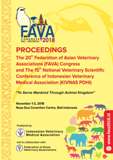PCS-12 Complex Oligosaccharide Detected in the Lingua of Hystrix javanica by Lectin Histochemistry
Abstract
Hystrix javanica or usually called Sunda porcupine is wildlife animal that only found in Java, Bali, Sumbawa, Flores, Lombok, Madura, and Tonahdjampea (Indonesia) [1]. International Union for Conservation of Nature and Natural Resources (IUCN) has classified this Rodentia into Least Concern criteria, that means the species is relatively widespread and abundant [2]. Nevertheless, their population in nature was threatened, since this mammal was considered as pest by some people.
There were anatomical data of Sunda porcupine organ, but it still limited. One of the ways to determine the detail function of the organ can be done by making histological preparations. Lectin histochemistry has been used widely as a probe to detect sugar residues in the organs or tissues because lectin can bind specifically to carbohydrate residues in term of glycoconjugates [3]. Analysis the composition or type of sugar residues in the organs can help to understanding the role of their function.
The aims of this study were to detect and find out the distribution of complex oligosaccharide in the lingua of Hystrix javanica using lectin histochemistry method. This data will completes the information that has been obtained before about mucopolysaccharide type of major salivary glands of Hystrix javanica [4].

